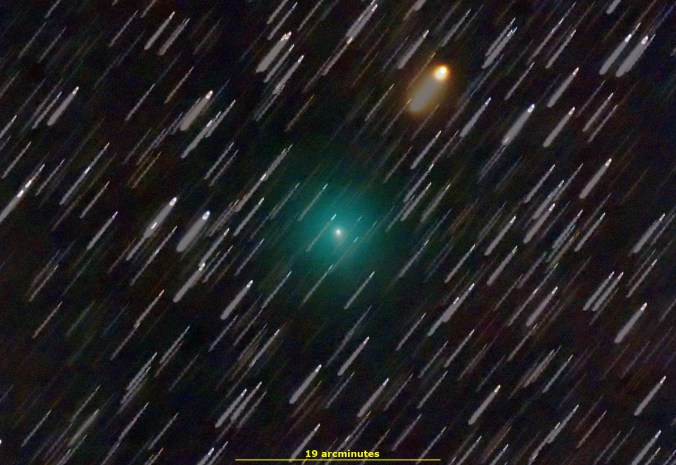March 4, 2020: Comet ATLAS (C/2019 Y4) is coming … and the sun is waiting. In late May, the dirty snowball will dip inside the orbit of Mercury, passing only 0.25 AU from the sun. No one knows what will happen when the comet’s icy core is exposed to solar heat at point blank range.
“ATLAS is a bit of a wildcard, and there’s a spectrum of possibilities as it nears the sun,” says Karl Battams of the Naval Research Lab in Washington DC. “At one extreme, it could simply crumble away in the coming weeks, and at the other extreme it could brighten up tremendously. It has an unusually small perihelion distance inside of Mercury’s orbit, which bodes well for getting those frozen gases fizzing furiously.”
At the moment Comet ATLAS is beyond the orbit of Mars. Even at that great distance, it is already brightening, shooting up 100-fold since the beginning of February. Currently, it looks like a fuzzy star of 11th magnitude in the Big Dipper–an easy target for backyard telescopes.
By the end of May, the comet could be as bright as a 1st magnitude star. Astronomers will be struggling to see it, however, through the glare of the approaching sun.
“All is not lost!” says Battams. “We have a number of space telescopes designed to view objects very close to the sun. For instance, the Heliospheric Imager on NASA’s STEREO spacecraft will get a great view of ATLAS from mid-May through early June. The camera is very sensitive, so we might be able to observe ATLAS’s tail interacting with the solar wind and outflows.”
Above: STEREO’s Heliospheric Imager recorded Comet PanSTARRS in 2013.
“There’s also the WISPR camera on NASA’s Parker Solar Probe,” he continues. “We will potentially be able view ATLAS from WISPR, concurrently with the STEREO observations, but it would require a non-standard pointing configuration for us, so the operation teams are currently assessing our options.”
Can’t wait for May? Amateur astronomers with mid-sized backyard telescopes can observe Comet ATLAS now. Monitoring is encouraged. Outbursts are possible in the weeks ahead as new veins of volatile material are exposed by intensifying sunlight. Point your optics using this ephemeris from JPL and submit your images here.
Realtime Space Weather Photo Gallery
Free: Spaceweather.com Newsletter
